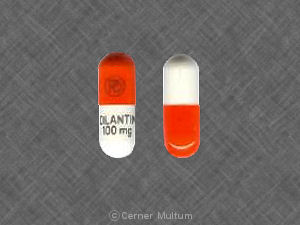Dilantin Infatabs Dosage
Generic name: PHENYTOIN 50mg
Dosage form: tablet, chewable
Drug classes: Group I antiarrhythmics, Hydantoin anticonvulsants
Medically reviewed by Drugs.com. Last updated on Sep 27, 2023.
Important Administration Instructions
NOT FOR ONCE-A-DAY DOSING. DILANTIN INFATABS can be either chewed thoroughly before being swallowed or swallowed whole.
Adult Dosage
The recommended starting dosage for adult patients who have received no previous treatment is two 50 mg Infatabs by mouth three times daily. Adjust the dosage to suit individual requirements up to a maximum of twelve Infatabs daily. For most adults, the satisfactory maintenance dosage will be six to eight Infatabs daily.
Pediatric Dosage
The recommended starting dosage for pediatric patients is 5 mg/kg/day by mouth in two or three equally divided doses, with subsequent dosage individualized to a maximum of 300 mg daily in divided doses. A recommended daily maintenance dosage is usually 4 to 8 mg/kg/day in equally divided doses. Children over 6 years and adolescents may require the minimum adult dosage (300 mg/day). If the daily dosage cannot be divided equally, the larger dose should be given before retiring.
Dosage Adjustments
Dosage should be individualized to provide maximum benefit. In some cases, serum blood level determinations may be necessary for optimal dosage adjustments. Trough levels provide information about clinically effective serum level range and confirm patient compliance, and are obtained just prior to the patient's next scheduled dose. Peak levels indicate an individual's threshold for emergence of dose-related side effects and are obtained at the time of expected peak concentration. Therapeutic effect without clinical signs of toxicity occurs more often with serum total concentrations between 10 and 20 mcg/mL (unbound phenytoin concentrations of 1 to 2 mcg/mL), although some mild cases of tonic-clonic (grand mal) epilepsy may be controlled with lower serum levels of phenytoin. In patients with renal or hepatic disease, or in those with hypoalbuminemia, the monitoring of unbound phenytoin concentrations may be more relevant [see Dosage and Administration (2.6)].
With recommended dosage, a period of seven to ten days may be required to achieve steady-state blood levels with phenytoin and changes in dosage (increase or decrease) should not be carried out at intervals shorter than seven to ten days.
Switching Between Phenytoin Formulations
The free acid form of phenytoin is used in DILANTIN-125 Suspension and DILANTIN Infatabs. DILANTIN extended capsules and parenteral DILANTIN are formulated with the sodium salt of phenytoin. Because there is approximately an 8% increase in drug content with the free acid form over that of the sodium salt, dosage adjustments and serum level monitoring may be necessary when switching from a product formulated with the free acid to a product formulated with the sodium salt and vice versa.
Dosing in Patients with Renal or Hepatic Impairment or Hypoalbuminemia
Because the fraction of unbound phenytoin is increased in patients with renal or hepatic disease, or in those with hypoalbuminemia, the monitoring of phenytoin serum levels should be based on the unbound fraction in those patients [see Warnings and Precautions (5.11) and Use in Specific Populations (8.6)].
Geriatric Dosage
Phenytoin clearance is decreased slightly in elderly patients and lower or less frequent dosing may be required [see Clinical Pharmacology (12.3)].
Dosing during Pregnancy
Decreased serum concentrations of phenytoin may occur during pregnancy because of altered phenytoin pharmacokinetics. Periodic measurement of serum phenytoin concentrations should be performed during pregnancy, and the DILANTIN dosage should be adjusted as necessary. Postpartum restoration of the original dosage will probably be indicated [see Use in Specific Populations (8.1)]. Because of potential changes in protein binding during pregnancy, the monitoring of phenytoin serum levels should be based on the unbound fraction.
More about Dilantin (phenytoin)
- Check interactions
- Compare alternatives
- Pricing & coupons
- Reviews (77)
- Drug images
- Latest FDA alerts (3)
- Side effects
- Dosage information
- During pregnancy
- Generic availability
- Drug class: group I antiarrhythmics
- Breastfeeding
Patient resources
- Dilantin drug information
- Dilantin injection
- Dilantin Infatabs (Advanced Reading)
- Dilantin-125 (Advanced Reading)
- Dilantin Infatabs
- Dilantin Kapseals
Other brands
Phenytek, Phenytoin Sodium, Prompt
Professional resources
- Dilantin prescribing information
- Dilantin Infatabs (FDA)
- Dilantin-125 (FDA)
- Phenytoin (AHFS Monograph)
Other brands
Related treatment guides
Further information
Always consult your healthcare provider to ensure the information displayed on this page applies to your personal circumstances.


